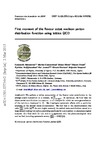First moment of the flavour octet nucleon parton distribution function using lattice QCD
| dc.contributor.author | Alexandrou, C | |
| dc.contributor.author | Constantinou, M | |
| dc.contributor.author | Dinter, S | |
| dc.contributor.author | Drach, V | |
| dc.contributor.author | Hadjiyiannakou, K | |
| dc.contributor.author | Jansen, K | |
| dc.contributor.author | Koutsou, G | |
| dc.contributor.author | Vaquero, A | |
| dc.date.accessioned | 2018-07-25T15:40:46Z | |
| dc.date.available | 2018-07-25T15:40:46Z | |
| dc.date.issued | 2015-06 | |
| dc.identifier.issn | 1029-8479 | |
| dc.identifier.issn | 1029-8479 | |
| dc.identifier.other | 68 | |
| dc.identifier.uri | http://hdl.handle.net/10026.1/11920 | |
| dc.description | 18 pages, 7 figures | |
| dc.description.abstract |
Abstract: We perform a lattice computation of the flavour octet contribution to the average quark momentum in the nucleon, (Formula presented.). In particular, we fully take the disconnected contributions into account in our analysis for which we use a generalization of the technique developed in [1]. We investigate systematic effects with particular emphasis on the excited states contamination. We find that in the renormalization free ratio (Formula presented.) (with 〈x〉<sup>(3)</sup> the non-singlet moment) the excited state contributions cancel to a large extent making this ratio a promising candidate for a comparison to phenomenological analyses. Our final result for this ratio is in agreement with the phenomenological value and we find, including systematic errors, (Formula presented.).[Figure not available: see fulltext.] | |
| dc.format.extent | 68- | |
| dc.language | en | |
| dc.language.iso | en | |
| dc.publisher | Springer Science and Business Media LLC | |
| dc.subject | Lattice QCD | |
| dc.subject | Deep Inelastic Scattering | |
| dc.subject | Lattice Gauge Field Theories | |
| dc.subject | Lattice Quantum Field Theory | |
| dc.title | First moment of the flavour octet nucleon parton distribution function using lattice QCD | |
| dc.type | journal-article | |
| dc.type | Journal Article | |
| plymouth.author-url | https://www.webofscience.com/api/gateway?GWVersion=2&SrcApp=PARTNER_APP&SrcAuth=LinksAMR&KeyUT=WOS:000363486400001&DestLinkType=FullRecord&DestApp=ALL_WOS&UsrCustomerID=11bb513d99f797142bcfeffcc58ea008 | |
| plymouth.issue | 6 | |
| plymouth.volume | 2015 | |
| plymouth.publication-status | Published | |
| plymouth.journal | Journal of High Energy Physics | |
| dc.identifier.doi | 10.1007/jhep06(2015)068 | |
| plymouth.organisational-group | /Plymouth | |
| plymouth.organisational-group | /Plymouth/Faculty of Science and Engineering | |
| plymouth.organisational-group | /Plymouth/Faculty of Science and Engineering/School of Engineering, Computing and Mathematics | |
| plymouth.organisational-group | /Plymouth/REF 2021 Researchers by UoA | |
| plymouth.organisational-group | /Plymouth/REF 2021 Researchers by UoA/EXTENDED UoA 10 - Mathematical Sciences | |
| plymouth.organisational-group | /Plymouth/REF 2021 Researchers by UoA/UoA10 Mathematical Sciences | |
| plymouth.organisational-group | /Plymouth/Users by role | |
| plymouth.organisational-group | /Plymouth/Users by role/Academics | |
| dc.identifier.eissn | 1029-8479 | |
| dc.rights.embargoperiod | Not known | |
| rioxxterms.versionofrecord | 10.1007/jhep06(2015)068 | |
| rioxxterms.licenseref.uri | http://www.rioxx.net/licenses/all-rights-reserved | |
| rioxxterms.type | Journal Article/Review |


